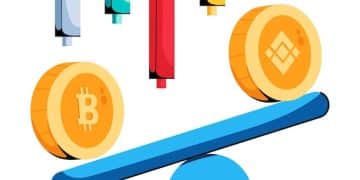Decentralized Lending on Solana: US Residents’ Guide to Borrowing & Lending Strategies

Decentralized lending on Solana offers US residents opportunities to borrow and lend cryptocurrency without intermediaries, utilizing strategies such as collateralization and yield farming for potential rewards and risks.
Decentralized finance (DeFi) is reshaping traditional financial systems, offering new avenues for borrowing and lending. For US residents, Solana’s blockchain provides a compelling platform for participating in decentralized lending on Solana: Borrowing and Lending Strategies for US Residents, offering potentially higher yields and greater control over their assets.
Understanding Decentralized Lending on Solana
Decentralized lending operates on blockchain technology, removing the need for traditional intermediaries like banks. On Solana, a high-throughput blockchain, this translates to faster transactions and lower fees compared to other platforms.
For US residents, participating in decentralized lending on Solana presents unique opportunities and challenges within the regulatory landscape. Understanding these nuances is crucial for informed participation.
Key Concepts of DeFi Lending
DeFi lending involves several core concepts that differentiate it from traditional finance. These concepts power the decentralized lending platforms.
- Collateralization: Borrowers typically need to provide collateral, often in the form of other cryptocurrencies, to secure their loans.
- Liquidation: If the value of the collateral falls below a certain threshold, the loan can be liquidated to protect the lenders.
- Smart Contracts: Lending and borrowing terms are governed by smart contracts, self-executing agreements that automate the process and ensure transparency.
These building blocks create a transparent and efficient lending ecosystem. Understanding smart contracts can help users navigate the decentralized finance space.
Understanding these features ensures users can safely engage with DeFi lending protocols. It allows for informed decision-making and risk management.

Benefits of Decentralized Lending for US Residents
Decentralized lending on Solana offers several potential benefits for US residents compared to traditional lending systems. These advantages are attracting an increasing number of users.
These benefits include increased accessibility, potentially higher returns, and greater control over assets. However, it is essential to understand and assess the associated risks before participating.
Accessibility and Financial Inclusion
DeFi lending platforms are often more accessible than traditional lending institutions. These platforms are open to anyone with a cryptocurrency wallet and internet connectivity.
This accessibility can be particularly beneficial for individuals who may be underserved by traditional financial systems. It promotes financial inclusion and empowers individuals to manage their finances.
Potential for Higher Returns
DeFi lending platforms often offer attractive interest rates for lenders. It may be higher compared to traditional savings accounts or fixed-income investments.
- Yield Farming: Depositing or lending assets to earn rewards in the form of additional tokens.
- Staking: Locking up cryptocurrency holdings to receive staking rewards.
- Liquidity Mining: Providing liquidity to decentralized exchanges (DEXs) to earn fees and incentives.
However, it is important to note that higher returns come with higher risks, including market volatility and smart contract vulnerabilities. US residents need to consider these factors when assessing potential DeFi lending strategies.
Understanding the risk versus reward in DeFi lending ensures informed participation. It allows for better decision-making and risk mitigation strategies.
Risks Involved in Solana Decentralized Lending
While decentralized lending on Solana presents opportunities, it also carries significant risks that US residents should be aware of. There is an essential need for robust risk management strategies.
These risks include smart contract vulnerabilities, impermanent loss, regulatory uncertainty, and market volatility. A proactive understanding of the potential pitfalls leads to safer participation.

Smart Contract Vulnerabilities
Smart contracts, the foundation of DeFi lending, are susceptible to bugs and exploits. Any undetected vulnerability can lead to fund losses.
Audits and security assessments can help mitigate these risks. However, even audited smart contracts can still have vulnerabilities that might only surface under specific conditions. The security in this space is always evolving.
Impermanent Loss
When providing liquidity to decentralized exchanges (DEXs), users may encounter impermanent loss. This loss occurs when the price of the deposited assets diverge.
This impermanent loss can reduce the overall profitability. US residents should carefully consider the risks and potential rewards before providing liquidity.
Regulatory Uncertainty and Market Volatility
The regulatory landscape surrounding DeFi is still evolving. Regulatory actions can significantly impact the DeFi market.
- Policy Changes: Legal and policy changes in the US may affect DeFi activities.
- Market Instability: Sudden market downturns can significantly impact the value of digital assets.
- Security Risks: Increased security measures are essential to protect against cyber threats.
It is important for US residents to stay informed and prepared for potential changes. This awareness ensures informed and responsible engagement.
These factors are a necessary precaution for all participants. A proactive stance ensures safer participation.
Strategies for Borrowing on Solana DeFi
Borrowing on Solana’s DeFi platforms can provide US residents access to capital without traditional credit checks. It can be a gateway to new investments and opportunities.
These strategies involve depositing collateral and managing loan-to-value ratios. Prudent borrowing is key to mitigating potential risks.
Collateralization Strategies
Most Solana DeFi lending platforms require borrowers to provide collateral. The deposited collateral secures the loan and mitigates risk for lenders.
Different platforms accept various cryptocurrencies as collateral. It’s always best practice to explore the options and choose the best one for an individual’s portfolio. The choice should align with their risk tolerance and needs.
Loan-to-Value (LTV) Management
LTV dictates the ratio of the loan amount to the collateral value. Managing this LTV ratio is critical to avoid liquidation.
- Monitoring Collateral: Keep a close watch on the value of the collateral.
- Avoiding Liquidation: Managing LTV carefully helps avoid liquidation.
- Maintaining Proper LTV: Keeping LTV at or below a specific level ensures a buffer.
Borrowers should understand the platform’s liquidation threshold and maintain sufficient collateral. Responsible management ensures a safer borrowing experience.
Careful management allows for a more predictable and secure experience. Proper planning is always an important aspect.
Strategies for Lending on Solana DeFi
Lending on Solana DeFi platforms offers US residents an opportunity to earn interest on their crypto assets. It can be a reliable way to grow holdings.
These strategies involve assessing risks and optimizing returns. Careful consideration is always an important practice to engage with the space.
Assessing Lending Platforms
Before lending on any Solana DeFi platform, thoroughly research and assess its reputation and security. Security and reputation are the foundations of a trustworthy platform.
Optimizing Returns
To maximize returns, compare interest rates across different platforms and lending pools. Different pools can offer varying rates.
- Diversification: Allocating capital across different lending pools can mitigate risk.
- Platform Due Diligence: Conducting thorough due diligence ensures fund safety.
- Staying Informed: Staying updated on the latest trends and developments optimizes strategy.
However, be mindful of the associated risks. Higher returns often come with higher risks, and potential impermanent loss.
These steps will help ensure responsible engagement. Preparation allows for a better experience.
Navigating the Regulatory Landscape in the US
The regulatory landscape for DeFi activities in the US is still evolving. This includes lending and borrowing activities. Therefore, awareness is key for compliance.
US residents should stay informed about current regulations and potential changes. Awareness ensures a proactive and compliant approach.
Understanding Current Regulations
The IRS has provided some guidance on the tax treatment of cryptocurrency transactions. This includes lending and borrowing activities within DeFi.
Future Regulatory Changes
The regulatory environment is likely to evolve. New regulations can impact DeFi activities in the US.
- Compliance: Following guidelines from regulatory bodies.
- Remaining Informed: Staying updated about changes in US regulations is important.
- Seeking Guidance: It is always helpful to consult with professionals.
It’s always best to consult with a qualified tax advisor to understand the implications of DeFi activities. A tax advisor is critical in navigating these changes.
Professionals can help explain any potential liabilities. Awareness remains a key factor for a positive experience.
| Key Point | Brief Description |
|---|---|
| 💡 DeFi Lending | Decentralized lending platforms enable peer-to-peer cryptocurrency loans. |
| 🛡️ Collateralization | Borrowers provide collateral to secure loans, ensuring lender protection. |
| ⚠️ Risks | Smart contract vulnerabilities and market volatility are key risks to consider. |
| ⚖️ Regulations | US residents should stay updated with evolving DeFi regulations for compliance. |
Frequently Asked Questions
What is decentralized lending on Solana?
Decentralized lending on Solana refers to borrowing and lending cryptocurrencies on the Solana blockchain without traditional intermediaries; transactions are facilitated by smart contracts.
What are the benefits of using Solana for DeFi lending?
Solana’s high throughput and low transaction costs make it suitable for DeFi lending, which translates to faster transactions and lower fees compared to networks like Ethereum.
What risks are involved in decentralized lending?
Risks include smart contract vulnerabilities, impermanent loss, market volatility, and regulatory changes; understanding these risks is essential for risk management.
How do I participate in borrowing or lending on Solana DeFi platforms?
To participate, users need a Solana wallet, SOL tokens for transaction fees, and a thorough understanding of the lending platform; depositing collateral is typically required for borrowing.
Are there any tax implications for DeFi lending in the US?
Yes, DeFi lending activities are subject to US tax regulations; users may owe taxes on interest income or capital gains, and should consult a tax professional for personalized advice.
Conclusion
Decentralized lending on Solana provides US residents with innovative opportunities to engage in the DeFi space. By understanding the benefits, risks, and regulatory landscape, and also following careful and safe practices, users can thoughtfully participate in creating an environment to borrow and lend their way.





